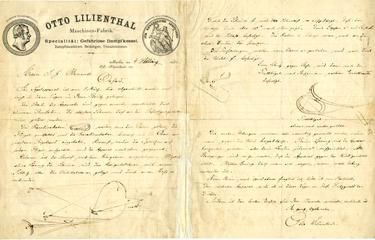
Lilienthal, Otto 1848 - 1896
- Nationality:
- German
(1848-1896) Engineer and Aviation Pioneer
Otto Lilienthal was born on 23rd May 1848 in the Prussian town of Anklam, now in Germany. Growing up he attended the local grammar school where subjects included the study of birds as well as mathematics under Gustav Sporer. This would be followed by further education in both Potsdam and Berlin during which time he undertook his first experiments, which would be published in 1889 under the title Der Vogelflug: als Grundlage der Fliegekunst, Brid Flight as a Basis for Aviation.
After finishing his studies, he undertook one year’s military service as a fusilier during the Franco-Prussian war and upon his return he was employed as a mechanical engineer with the Weber Company in Berlin. A year later in 1872 he became a construction engineer at the C. Hoppe Machine Factory located in before. Also, around this time, in 1873, Otto and his brother, Gustav, became members of what would become the Royal Aeronautics Society and a year later he began his experiments into the forces acting on artificial wings. These experiments, credited as the beginning of wing-aerodynamics, led to a number of important discoveries, included demonstrating the advantages of curved wings and examining this in terms of lift and drag rather than as a single air force. He also analysed wing construction producing information about aspect ratio, wing shape and profiles, displaying these results in a polar diagram. He also developed measuring instruments that were able to these experiments into air flow including a whirling arm and an instrument to measure the force of the wind.
In 1877 he patented a mining machine, the first of 23 patents he would register, four of which would related to aviation, and in 1883 Lilienthal established his own engineering company producing steam engines and boilers on Kopenicker Strasse, Berlin. This company, Maschinen-Fabrik O. Lilienthal, was active until 1914 producing small steam engines that could be wall mounted.
By 1890 Otto Lilienthal had begun to experiment with manned gliders and by 1891 had undertaken his first successful flight of about 80 feet. This was the first controlled, and therefore reproducible, flight and was undertaken using the Derwitzer Glider, so called as the first flight had been undertaken near Derwitz, now in the German State of Brandenburg. Following this success, he undertook further flights in a new design, the Sudende Glider which was able to achieve distances up to 90 yards after being launched from a height of 30 feet. New designs followed this, including one which achieved the longest flight at the time, over a distance of 800 feet, and several that tried to incorporate flapping motion, either powered by the pilot or motors, which were not a success. The majority of these experiments had been undertaken in the hills around Berlin but in 1893 he constructed his Fliegeberg, Flight Hill, in Lichterfelde, Berlin. This 15 metre mound was built so that glider flights could be undertaken no matter the direction of the wind and it would be the site of thousands of flights.
In 1894 Otto began production of his Normalapparate, Normal Glider, which was an evolution of the designs that had come before it. This had a wind span of between 22 and 23 feet, a wing area of 140 to 146 square feet and weighed about 20kg. It is also credited with being the first aircraft to be serially produced, as nine are known to have been built and sold to various customers. Lilienthal would later add an additional wing to create a biplane.
Otto Lilienthal died on 10th August 1896 following an accident the day before. He had been undertaking a series of flights in his Normalapparate when on his fourth flight it pitched steeply down. He was unable recover and fell from a height of 49 feet, 15 metres. Although he was taken to Stolin and examined by a doctor and was later taken to Berlin for surgery, he had broken his vertebra and died 36 hours after the crash. He had a major impact on the field of aviation, with the Wright brothers crediting him as a major inspiration in their decision to pursue manned flight. His impact was also furthered by the numerous photographs that were taken of his flights, often at his own request. These were partly used to documents his experiments, but they also appeared in numerous publications and helped to spread his fame around the world.
In 1988 Berlin Tegel airport was renamed in his honour as Berlin Tegel "Otto Lilienthal" Airport.